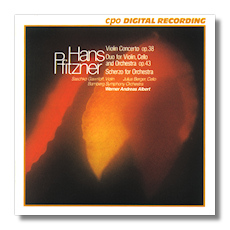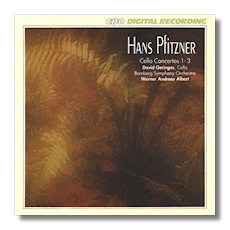
The Internet's Premier Classical Music Source
Related Links
- Pfitzner Reviews
- Latest Reviews
- More Reviews
-
By Composer
-
Collections
DVD & Blu-ray
Books
Concert Reviews
Articles/Interviews
Software
Audio
Search Amazon
Recommended Links
Site News
 CD Review
CD Review
Hans Pfitzner

Concertos
- Violin Concerto in B minor, Op. 34 (1924)
- Duo for Violin, Cello & Orchestra, Op. 43 (1937)
- Scherzo for Orchestra (1888)
Saschko Gawriloff, violin
Julius Berger, cello
Bamberg Symphony Orchestra/Werner Andreas Albert
CPO 999079-2 1990 56:33


- Cello Concerto in A minor, Op. 52 (1943)
- Cello Concerto in G Major in One Movement, Op. 42 (1935)
- Concerto for Cello in A minor, Op. posth. (1888)
David Geringas, cello
Bamberg Symphony Orchestra/Werner Andreas Albert
CPO 999135-2 1993 59:53
Also available in a 5CD boxed set with all the orchestral works, CPO 999249-2
Amazon
- UK
- Germany
- Canada
- France
- Japan
- ArkivMusic
- CD Universe
Critical Summary: Beautiful, intensely lyrical, mostly gentle, late Romantic music, beautifully performed and recorded, by a composer not known as one of the beautiful people. Particularly compelling Violin Concerto.
These are not recent releases, but three months ago I happened to hear the Violin Concerto on Wisconsin Public Radio, found it arresting, and acquired this recording of it. A few weeks later I bought the cello concertos and today his symphonies arrived in the mail.
After quite a few hearings I have decided that as far as I am concerned the Pfitzner Violin Concerto is one of the most satisfying concertos for that instrument. The cello concertos and this early Scherzo are also very fine. That these and other Pfitzner works are not played or recorded much outside of Germany is, I tend to assume, largely due to strictly extra-musical reasons, which I have been wrestling with and will address later.
Pfitzner's creative life spanned well over half a century, from around 1888 to the 1940s. His style was always conservative and did not really change much over the years. He was not nearly conservative enough for the truly reactionary Director of the Frankfurt Conservatory, who, incensed that Pfitzner's first cello concerto included instrumentation for three trombones, and had "Wagnerian" sounding harmonic augmentation of triads, stormed out of the trial performance, as Pfitzner relates, so Pfitzner never graduated. Notwithstanding, Pfitzner certainly mastered all needed compositional skills. Hans-Christian Schmidt, a musicologist on the faculty of the University of Osnabrück, with a few books to his credit, and who contributes extensive analytical notes to these recordings, attests to this. Schmidt calls Pfitzner "as much a faded traditionalist as a feeble avant-gardist," a "conservative nonconformist" who "does not admit of stylistic classification."
In general, Pfitzner's music is melodically beautiful and he uses a large orchestra sparingly, with particularly effective use of the woodwinds and, on occasion, solo trumpet and horn. He uses the full range of his solo instruments; dynamics range from very soft to very loud, though are generally quite moderate; tempos range from quite slow to presto. Structurally, this music uses variation form, counterpoint and more or less continuous development.
The lively and energetic (Lebhaft, energisch) opening movement of the Violin Concerto is intensely lyrical rather than dramatic, and at the beginning both violin and orchestra soar, though melody in this movement is frequently in short phrases. All of the ensemble's sections have their say, with flute trills and oboe solos, some brief but haunting horn and trumpet calls, then prominent brass, followed by a skipping motion in the strings, which is later taken up by the soloist. Drums, cymbals and triangle are also heard, though percussion is not particularly prominent in Pfitzner's concertos.
The short, slow second movement is marked "sehr getragen" (very stately) though this does not preclude a very loud central passage, rather Mahler-esque, perhaps, which subsides nicely. It begins with a beautiful oboe solo and toward the end there is some exquisite music where the oboe plays over the strings, is joined by the harp, which has the last word.
The long third movement, close to half the length of the whole concerto, begins with long melodic lines, and contains striking, in fact gorgeous outpouring of melody, sometimes perky, sometimes soaring, as in Prokofieff's violin concertos. There is also a fortissimo outburst, and the buildup at the end is reminiscent of Richard Strauss, though there is a hushed moment before the music rushes to a final thump. I might prefer that Pfitzner had re-written the ending, though I am sure that live audiences would have no objection to it.
Schmidt, in his extensive notes, calls this work brilliant and inspired (a comment that would have pleased Pfitzner, who valued musical inspiration highly). He likes Pfitzner's structural approach, his subtle, transformative "thematic dramaturgy" and his "concentration and economy." Somewhat confusingly, he sees the concerto as "of one movement in the guise of four movements," though he does proceed in terms of the three movements I mentioned. In the first of these, Schmidt notes three themes, with the third of these having seven variations; the last of those prepares thematically for the slow movement. The cadenza is transformative rather than flashy. Schmidt describes the rhythm of the slow movement as "steady forward striding," and he finds the third movement humorous and witty.
The Duo for violin, cello and orchestra, less than half the length of the Violin Concerto, and without key signature, is in three movements (6'32, 2'40, 4'43) which flow into one another. In fact, the music is mostly of a flowing sort, and quite beautiful. Schmidt calls it chromatic but tonal, song-like and rhapsodic. He finds the first two themes of the first movement dark and mournful, which I would not have been immediately inclined to identify as such. In the third movement Schmidt notes a Brahmsian "permanent development."
The ten and a half minute scherzo was written when Pfitzner was a nineteen year old student at the Frankfurt Conservatory. I find it a delightful work, with vigorous dance-like rhythms and appealing melody. It reminded me of some of Dvořák's scherzos; Schmidt sees "fugal style" akin to Mendelssohn's Midsummer Night music; and a musical friend I tried a blindfold test on thought it sounded somewhat like Bruckner. Pfitzner uses some pentatonic scales in this work.
The Cello Concertos are all very pleasurable to listen to, and span Pfitzner's long career. The first was written around the time of the Scherzo, for a fellow-student who was a cellist. Its initial hostile reception was recounted in my introduction to Pfitzner above. Its next misadventure was being returned to the composer by Max Bruch for want of the necessary postage. Then it went missing, until 1928, only to be lost again during World War II. In 1975 it turned up in the Austrian National Library in Vienna and was premièred in Würzburg in 1977. Meanwhile, its composer had used material he remembered from this concerto in his later A minor concerto.
The 1888 A minor cello concerto is in two long movements (11'38 and 13'53). Each begins slowly and quietly. It is a virtuoso vehicle for the soloist, making use of the instrument's full range; there are double stops and rapid passages. Schmidt sees the orchestral part as accompaniment only, though I would not say that. The orchestra has plenty to do and is sometimes quite forceful about it, and at one point is downright Tchaikovskian in its intensity. Midway in the first movement there is vigorous expression of rising excitement. A drum roll concludes the movement. The second movement has a beautiful hushed beginning for strings and the soloist enters after a full minute with a long melody, mostly legato. Winds and horns effectively join in and, midway there is really loud brass. Pfitzner is a wonderful orchestrator. Calm and quiet return in the last three minutes of the work, in great contrast to the way the Violin Concerto ends.
The G Major concerto from 1935, in a single – nearly fifteen minute – movement, begins melodiously with the solo cello, upper strings soaring above, until the accompaniment becomes chirping in character. This is very lyrical music. Its character changes a third of the way through with a trumpet call and a faster pace. Lyricism yields to intensity for a time but this in turn eases. Winds and brass become more prominent and eventually there is a loud outburst. A nice trumpet solo introduces a rather wistful cello in dialogue with a flute before a quiet end. The cello in this concerto takes a role as melodic leader rather than virtuoso vehicle. Schmidt finds a single theme with continuous development throughout and says "this is the only thing that really happens in this concerto."
The A minor concerto from 1943 is in four movements designated, respectively: restful, not too fast, solemn and Allegretto. Its duration is less than 19 minutes. The not too fast movement is lively just the same, and the solemn movement seems more pensive than solemn to me. The fourth movement is vigorous and the four movements work together very well. The opening movement is by far the most substantial and quite lovely. Schmidt, with slight hesitation, sees this late work as retrospective. As mentioned, Pfitzner reworked some older material for this work, including one of his Op. 32 songs.
Pfitzner The Man
In view of the loveliness of his music, I have agonized over how or whether to include an account of Pfitzner's life and character and what I have decided is not only that I would hear about it if I did not, but that it is an important part of the social history of German music in the 20th Century.
In his early maturity Pfitzner had a tentative friendship with Gustav Mahler and a friendship with Alma Mahler sufficient to arouse some jealousy on Gustav's part. In her 1946 book, Gustav Mahler: Memories and Letters, Alma relates how Gustav initially refused Pfitzner's "degrading" pleas that Mahler perform his opera "Die Rose vom Liebesgarten" because the libretto was bad, too long and with obscure symbolism. Later Mahler evidently did perform it (perhaps after revisions?) and even attended another production of it.
In 1923, as I was very sorry to learn from Alex Ross' recent The Rest Is Noise (which leaves open the question as to whether there was such a thing as a Nazi sound) Pfitzner was visited in the hospital by the already active Hitler and they discussed "Jewish war crimes." A hugely ironic turn is that at the time Pfitzner was wearing "a thin, faintly rabbinical beard, which gave Hitler the false impression that the composer was Jewish." Goebbels subsequently wrote (in 1943) that "The Fuehrer is strongly opposed to Pfitzner…He considers him a half Jew." Notwithstanding, Schmidt reports, Pfitzner in 1937 had somehow become a Reichskultursenator. After the war he underwent de-nazification.
Many years ago it was Jacques Barzun, the cultural historian among whose books were Berlioz and his Century, as well as Darwin, Marx, Wagner, who first impressed on me the truth that even the most intense appreciation of beauty and the arts is wholly insufficient to make one a good person. The fact that some Nazis were aesthetes certainly is more than enough to prove this. Conversely, though, even persons who are less than morally admirable may be capable of producing good works of art or music. Regardless of one's judgment on Pfitzner the human being, he did succeed in producing some fine concertos which are well worth hearing. In fact, if it had not been for his odious later personal history his music very likely would be more widely appreciated.
Copyright © 2008, R. James Tobin




















